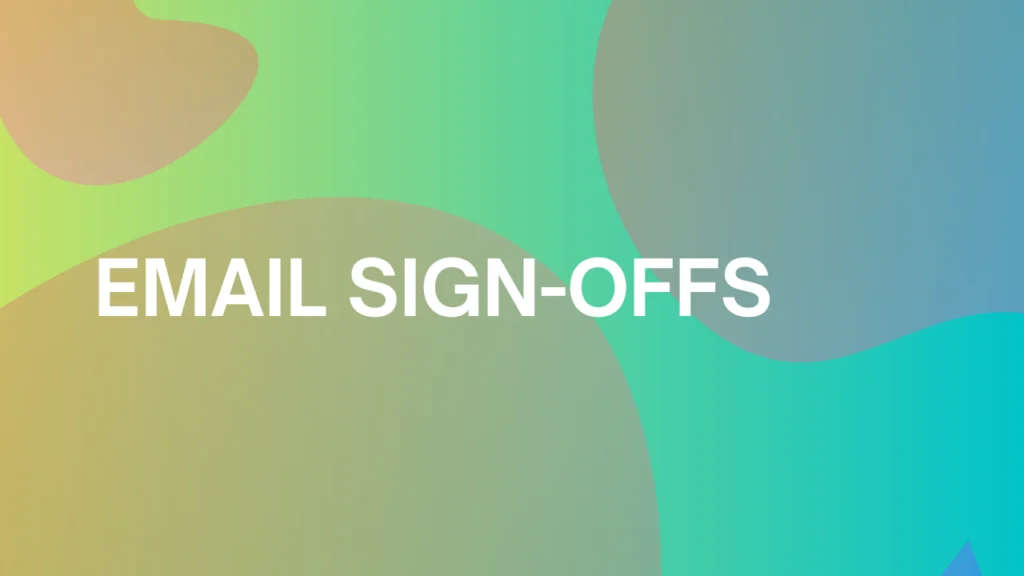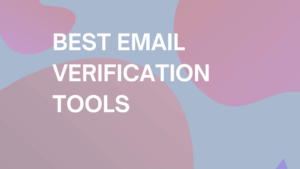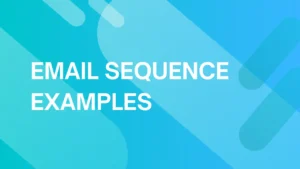How you conclude an email can significantly influence the recipient’s perception of you and your message. That’s why mastering the art of email sign-offs is crucial.
What are email sign-offs?
An email sign-off is the final touch you place on your digital correspondence, positioned just before your signature.
Think of it as the bow on a present – it wraps up your message neatly and leaves a lasting impression. More than mere tradition, a proper email sign-off serves several key functions:
- Marks the conclusion: It clearly indicates that your message has ended, neatly packaging your communication.
- Reflects courtesy: Much like saying “please” and “thank you,” it’s a nod to digital politeness.
- Sets the tone: The right sign-off can reinforce the sentiment of your message, whether it’s professional, friendly, or casual.
- Personal touch: It can personalize a message, adding a touch of warmth or professionalism, depending on your choice of words.
Choosing the right email sign-off is an art that balances etiquette, intention, and context. It ensures that your message is not only complete but also leaves the impression you intend.
How to sign off on an email?
Selecting the right email sign-off is like hitting the ‘send’ button—it’s the final step that ensures your message is delivered just as you intended. Here’s how to expertly navigate this crucial part of your email communication.
- Understand the purpose of your email: The intent behind your email should guide your sign-off choice. Whether you’re making a request, providing information, or expressing gratitude, your sign-off should echo this purpose.
- Consider the relationship: The nature of your relationship with the recipient plays an essential role in selecting an appropriate sign-off. A more familiar and informal relationship might allow for a relaxed sign-off, while professional contexts require a more formal approach.
- Reflect the email’s tone: Ensure your sign-off is consistent with the tone of your email. A mismatch between a casual body and a formal sign-off (or vice versa) can send mixed signals to the recipient.
- Encourage action or response: If your email is designed to get a specific action or response, consider a sign-off that gently nudges the recipient in that direction. For example, “Looking forward to your feedback” or “Please let me know your thoughts at your earliest convenience” sets clear expectations without being demanding.
What are the different types of email sign-offs?
A study by email productivity software provider Boomerang found that emails that include a closing receive a higher response rate than the average response rate of all emails, which was 47.5%.
Selecting the ideal sign-off for your email is not just a mark of professionalism but also an opportunity to leave a lasting impression. Whether you’re aiming to maintain a tone of formality or looking to add a personal touch, the right closing can significantly impact the recipient’s perception. Let’s take a closer look at different email sign-offs to determine which lines perfectly match your message and who you’re writing to.
1. Universal email sign-offs
These are your go-to options that fit a wide range of emails, from the slightly formal to the casually professional. They’re safe bets when you’re unsure about the most appropriate tone to adopt.
- “All the best” – A friendly yet professional way to wish someone well.
- “Many thanks” – Expresses gratitude while maintaining a professional tone.
- “Warm regards” – Offers warmth and professionalism, suitable for both business and personal emails.
- “Stay tuned” – Promises upcoming information or announcements.
- “Looking forward to your feedback” – Invites a response in a polite and professional manner.
- “Let me know if you need anything else” – Offers help, making it ideal for service-oriented messages.
- “Respectfully” – A sign-off that shows a high level of respect, fitting for formal and semi-formal emails.
- “With appreciation” – Expresses gratitude and respect, ideal for emails where you’re thanking the recipient.
- “Hope to hear from you soon” – A polite way of encouraging a reply without being too forward.
- “Thank you in advance” – Shows gratitude for future actions by the recipient.
- “Eagerly awaiting your thoughts” – Implies you’re looking forward to their input.
- “Best moving forward” – Suitable for a variety of emails, especially when discussing next steps or future plans.
- “Continued success” – Wishes the recipient ongoing achievement and prosperity, making it perfect for professional correspondences, particularly after discussing successes or positive outcomes.
- “Appreciate your time” – Expresses gratitude and respect for the recipient’s attention, perfect for follow-ups or requests.
- “Here if you need anything” – A supportive and service-oriented close that reinforces your willingness to help.
- “Until next time” – Offers a gentle, forward-looking sign-off that implies future contact.
- “Looking forward to hearing from you” – Friendly and forward-looking, ideal for prompting a reply.
- “Talk soon” – A warm, low-key close that works in both professional and familiar settings.
- “Much appreciated” – Communicates gratitude in a casual yet professional tone. Ideal when someone has helped or is about to.
- “In the meantime” – A subtle way to acknowledge a pending response or action, perfect for ongoing conversations.
- “Thank you for reading” – Acknowledges the recipient’s time and attention, often used in informational or announcement-style emails.
- “Until then” – Suggests a natural pause or gap until the next update. Works well when a follow-up is expected.
- “Looking forward to what’s next” – A positive and forward-thinking sign-off, excellent after project discussions or planning sessions.
2. Formal phrases to end an email
These sign-offs convey respect and formality, ideal for new contacts, official correspondence, or any situation where you want to project professionalism.
- “Best regards” – A versatile and universally accepted sign-off that balances warmth with professionalism.
- “Kind regards” – Slightly warmer than “Best Regards,” suitable for semi-formal business emails.
- “Looking forward to hearing from you” – Indicates anticipation for the recipient’s reply.
- “With respect” – Conveys a deep sense of respect, ideal for emails to senior professionals.
- “Professionally yours” – Asserts a strong professional relationship.
- “In corporate unity” – Suggests a shared mission or purpose, ideal for emails within the same organization.
- “Awaiting your response” – Implies you are waiting for their input, reinforcing the importance of their feedback or decision.
- “Sincerely” – A classic sign-off that works well in formal business contexts.
- “Hope this helps” – A semi-professional sign-off that offers assistance, suggesting you’re open to providing further support if needed.
- “Looking forward to our next meeting” – Shows anticipation for future interactions, with a personal note.
- “Yours faithfully” – Used when you don’t know the name of the person you are writing to, showing respect and professionalism.
- “Yours truly” – A somewhat formal yet personal sign-off, suitable for when you have some knowledge or connection with the recipient.
- “Eager for your reply” – Signals your keen interest in hearing back.
- “With gratitude and respect” – Combines appreciation with formality, ideal for senior-level communication.
- “Yours in collaboration” – Emphasizes partnership and teamwork, suitable for interdepartmental or cross-functional outreach.
- “Committed to excellence” – A bold, confident sign-off that works in performance- or quality-driven messages.
- “With due diligence” – Best used when sharing research, analysis, or careful decisions. Implies thoroughness and professionalism.
- “In professional partnership” – A strong closing that underlines mutual goals and business alignment.
3. Informal email endings
When emailing colleagues you’re familiar with or when aiming to create a warm, approachable vibe, these sign-offs can add the perfect friendly touch. This is a great place to use emojis too to further personalize your message, making it feel more approachable and less formal.
- “Cheers” – Informal and cheerful, suitable for people you have a good rapport with.
- “Best wishes” – Conveys a sense of goodwill without being overly casual.
- “Warmest regards” – Adds a touch of warmth, making it ideal for friendly business emails.
- “Take care” – A personal and caring sign-off that works well for someone you know personally.
- “Have a great day/week/weekend” – Offers a personalized touch of care, perfect for ending your email on a positive note.
- “Keep up the great work” – Encouraging and supportive, perfect after acknowledging someone’s efforts.
- “Thanks again” – Shows appreciation and gratitude, adding a personal touch.
- “Stay awesome” – A breezy, upbeat way to say goodbye.
- “Wishing you well” – A heartfelt and sincere sign-off that conveys genuine care and good intentions.
- “Until our paths cross again” – Implies anticipation for future meetings or interactions, carrying a tone of warmth and expectation.
- “Be Well” – A simple yet profound way to end an email, wishing the recipient health and happiness.
- “Catch you later” – Informal and fun, suitable for people you know well.
- “Stay golden” – This evokes a sense of enduring value and positivity, ideal for those moments when you wish to remind someone of their worth or to keep a positive mindset.
- “Appreciate you!” – Casual, grateful, and personal — best suited for colleagues or collaborators you know well.
- “Talk soon-ish” – Relaxed and playful, great for informal updates when the exact next time isn’t set.
- “Keep in touch” – Encourages ongoing communication while maintaining a light tone.
- “Catch you on the next thread” – Friendly and tech-savvy, particularly suitable for frequent internal email chains.
- “You’ve got this” – Motivational and personal, great for offering encouragement or closing after support.
Whether you opt for a professional closure, inject a friendly touch with or without emojis, or choose a universal sign-off, make sure it matches your message’s body and the relationship you have with the recipient.
4. Call to action sign-offs
Sometimes, the goal of your email is to prompt the recipient to take a specific action. These sign-offs help make your call-to-action clear and compelling.
- “Click the ‘Book Now’ button below” – Directly encourages making an appointment or scheduling a meeting.
- “Discover more on my blog” – Guides the recipient to additional resources or reading material.
- “Let’s connect on [Platform]” – Invites the recipient to engage with you on social media or another platform.
- “Reply to schedule a chat” – Makes it easy for the recipient to initiate further discussion.
- “Feedback welcome” – Opens the door for the recipient to share their thoughts or opinions.
- “Please review the attached document and let me know what you think” – Encourages a detailed review and feedback, fostering a collaborative dialogue.
- “Don’t miss our next webinar” – Combines information with action, encouraging participation in future events.
- “We’re eager for your feedback” – Directly asks for the recipient’s thoughts, showing that their opinion matters.
- “For more info, visit our site” – Encourages the recipient to engage further with your content or services.
- “Mark your calendar for our exciting event” – Acts as a friendly nudge to ensure the recipient remembers and prioritizes your upcoming event.
- “Let’s get things rolling” – A dynamic closing to inspire movement or kick off new work.
- “Awaiting your green light” – Professional yet playful, ideal when seeking approval or sign-off.
- “Review when ready” – A casual but clear sign-off, giving the recipient space to review content on their time.
- “Let me know where you land” – Encourages the recipient to share their decision or thoughts after consideration.
- “Hoping to hear your perspective” – Polite and thoughtful, best for opinion-based replies or idea-sharing.
5. Conversational and uplifting sign-offs
These sign-offs bring warmth, encouragement, and a sense of sincerity to your emails. Ideal when tone matters just as much as the message itself, they help reinforce connection, motivation, and ongoing support.
- “Let’s connect soon” – Great for networking, follow-ups, or keeping communication lines open.
- “Ping me if anything changes” – Friendly and flexible, ideal for ongoing discussions or project updates.
- “Just reply when you can” – Casual and understanding, shows respect for the recipient’s time.
- “Drop me a line if needed” – Invites further communication without pressure.
- “Always happy to help” – Shows availability and willingness to support, especially in service or account management roles.
- “Here’s to progress” – Optimistic and motivating, great for closing updates or reflections on growth.
- “To better days ahead” – Encouraging and hopeful, especially useful in empathetic or challenging situations.
- “Let’s make it happen” – Empowering and direct, ideal when encouraging forward motion.
- “Keep the momentum” – A sign-off that emphasizes continuity and action, great for post-launch or follow-up emails.
- “Rooting for your success” – Genuine and heartfelt, this phrase works well when you want to leave a lasting impression of support.
Best practices on email sign-offs
Ending an email the right way is crucial. Here’s a simple guide to ensure your sign-offs are spot-on, perfectly capturing your intended message.
- Adapt to the Email’s Context: Tailor your sign-off to fit the tone and purpose of your email. A formal request might end with “Best regards,” while a casual update to a colleague could simply use “Thanks.” Matching your sign-off to the context keeps your emails cohesive and appropriate.
- Balance Professionalism with Personality: Even in formal settings, a slight personal touch in your sign-off can set you apart. Opt for “Warm regards” to convey friendliness without compromising professionalism.
- Clarity and Simplicity: Aim for sign-offs that are straightforward and unmistakable. This ensures your intention is clear, avoiding any potential confusion about the conclusion of your message.
- Positivity in Tone: Encourage continued conversation and leave a positive impression with sign-offs like “Looking forward to your response.” Such closures invite dialogue and demonstrate your eagerness for interaction.
- Flexibility and Variation: Feel free to vary your sign-off based on the email’s content and the recipient, preventing your messages from becoming monotonous. This approach keeps your emails engaging and dynamic.
- Reflect the Email’s Mood and Your Relationship: Ensure your sign-off is in harmony with the overall tone of your email and your relationship with the recipient. This alignment prevents misinterpretation and maintains the intended message.
- Include Contact Details: Especially in initial correspondences, follow your sign-off with your full name, position, and other relevant contact information. This makes it easy for recipients to respond or reach out as needed.
- Audience Awareness: Customize your sign-off considering your relationship with the recipient, ensuring it’s suitable and respectful. This fosters positive interactions and respect.
- Proper Grammar and Punctuation: Begin your sign-off with a capital letter, followed by a comma, and ensure correct punctuation throughout. This attention to detail reflects your professionalism and attention to detail.
- Avoid Overly Formal or Archaic Phrases: Terms like “Yours faithfully” can appear out of place in emails, giving off an overly formal or outdated vibe.
- Steer Clear of Excessive Emotion: Reserve affectionate sign-offs like “Love” or “XOXO” for personal emails. In professional contexts, they can be perceived as inappropriate or overly familiar.
- Refrain from Using Abbreviations or Slang: Professional emails should avoid casual language, abbreviations, or slang that might confuse or appear unprofessional to the recipient.
- Avoid Negative or Passive-Aggressive Tones: A sign-off should never leave a sour taste. Ensure your closing is genuine and does not hint at any underlying negativity or passive aggression.
Tip:Remember, the right sign-off resonates with your message, aligns with your professional identity, and leaves a lasting positive impression on your recipient. Besides email sign off, you should also pay attention to other parts of email content such as the overall message and subject line. In order to maximize the performance of your email campaigns and deliverability, you can use our free tools:
Our best email sign-offs
Here, at itrinity, we keep things interesting by matching sign-offs with our content or product:
“Emojis are a fun bonus, I stick to the same sign-off to create brand recognition.” (Nikolina Zeljko, Email Specialist at itrinity)
Here are some examples that we use as email sign-offs:
- Mangools: “SEO you soon!“
- UptimeRobot: “Have a great (up)time!“
- Warmup Inbox: “Happy warming up ✉️🔥“
- EmailListVerify: “Have your email list polished like never before. ✨“
- Geo Targetly: “Have a geotastic day! 🌍“
Frequently Asked Questions
What is an email sign-off?
An email sign-off is the closing part of an email where the sender typically includes a closing remark followed by their name. It’s the final opportunity to leave a lasting impression on the reader, akin to saying goodbye in a conversation.
What should every sign-off have?
Every sign-off should include a courteous closing phrase that matches the tone of your email, followed by your name. Optionally, you can also include your job title, company, and contact information, depending on the formality and context of the email.
What are the different types of email sign-offs?
Email sign-offs can broadly be categorized based on the tone and context of your correspondence. They range from formal and professional to friendly and casual, each serving a different purpose and audience.
How do you sign off a polite email?
To sign off a polite email, use respectful and considerate closing phrases such as “Kind regards,” “Best wishes,” or “Warm regards.“ These convey a sense of professionalism and courtesy, making them suitable for most professional and personal correspondences.
What are the most popular email sign-offs?
The popularity of email sign-offs often depends on the industry, the relationship between the sender and the recipient, and the email’s content. However, some sign-offs have universal appeal due to their balance of warmth, professionalism, and clarity. “Best regards,” “Warm wishes,” and “Sincerely” are among the top choices for many professionals, offering a safe and respectful way to conclude various types of emails.




